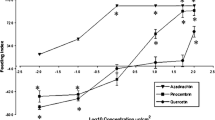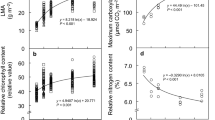Abstract
Hypericin, an anthrone dimer inHypericum perforatum (Guttiferae), is shown for the first time to be phototoxic to generalist lepidopteran larvae; survivorship was reduced and development prolonged forHeliothis zea (Noctuidae) andPlatynota flavedana (Tortricidae) that consumed hypericin diets in the presence of light. Survivorship for both species is enhanced when photoactivating wavelengths are excluded by filters. In natureP. flavedana successfully survives onH. perforatum by tying together leaves and feeding inside the ties. Shielded from light, the larvae are protected by their mode of feeding from phototoxic compounds.
Similar content being viewed by others
References
Berenbaum, M. 1978. Toxicity of a furanocoumarin to armyworms: A case of biosynthetic escape from insect herbivores.Science 201(4355):532–533.
Blum, H.F. 1941. Photodynamic Action and Diseases Caused by Light. American Chemical Society Monograph Series No. 85. Reinhold, New York. 309 pp.
Bradley, J.D.,Tremewan W.G., andSmith, A. 1973. British tortricoid moths. Cochylidae and Tortricidae: Tortricinae. Ray Soc. 251 pp.
Bradley, J.D.,Tremewan, W.G., andSmith, A. 1979. British Tortricoid moths. Tortricidae: Oleuthreutinae. Ray Soc. 336 pp.
Brockmann, H., andSanne, W. 1957. Zur Kenntnis des Hypericins und Pseudohypericins.Chem. Ber. 90:2480–2491.
Brockmann, H., Pohl, F., Maier, K., andHaschad, M.N. 1942. Über das Hypericin, den photodynamischen Farbstoff des Johanniskrautes (Hypericum perforatium).Just. Lieb. Ann. Chem. 553:1–52.
Champagne, D.E., Arnason, J.T., Philogene, B.J.R., Morand, P., andLam, J. 1986. Light-mediated allelochemical effects of naturally occurring polyacetylenes and thiophenes from Asteraceae on herbivorous insects.J. Chem. Ecol. 12(4):835–858.
Chauvin, R. 1967. The World of an Insect. World University Library, McGraw-Hill, New York. 256 pp.
Clare, N.T. 1952. Photosensitization in diseases of domestic animals. Commonwealth Bureau of Animal Health Review Services No. 3. 58 pp.
Currie, G.A., andGarthside, S. 1932. The possibility of the entomological control of St. John's wort in Australia—progress report. Council Science Industrial Research of Australia. Pamphlet 29. 28 pp.
Fienberg, S.E. 1977. The analysis of Cross-Classified Categorical Data. Massachusetts Institute of Technology Press, Cambridge, xi+151 pp.
Gates, D.M. 1980. Biophysical Ecology. Springer-Verlag, New York. 611 pp.
Giese, A.C. 1980. Hypericism.Photochem. Photobiol. Rev. 5:229–255.
Harris, P. andPeshkin, D. P. 1974. Biological control of St. John's-wort.Can. Ag. 19:13–15.
Hodges, R.W. 1974. The Moths of America North of Mexico. Fasc. 6.2 Gelechioidea, Oecophoridae. E.W. Classey Ltd. and R. B. D. Publ., London. 142 pp. + plates.
Johannson, S. 1962. Insects associated withHypericum L. 2. Lepidoptera, Diptera, Hymenoptera, Homoptera, and general remarks.Opusc. Entomol. 28(3):175–192.
Kingsolver, J.M., Batra, S.S.T., andUtmar, J.A. 1984. A selected bibliography of insect-vascular plant associational studies. U.S. Department of Agriculture Bibliographs and Literature of Agric. No. 27. 229 pp.
Knox, J.P., andDodge, A.D. 1985. Isolation and activity of the photodynamic pigment hypericin.Plant Cell Environ. 8:19–25.
Marsh, C.D., andClawson, A.B. 1930. Toxic effect of St. Johnswort (Hypericum perforatum) on cattle and sheep. U.S. Department Agriculture Technical Bulletin No. 202. 23 pp.
Nelson, H.S. 1962. Untersuchungen zur biologischen Bekampfung vonHypericum perforatum L. mit Hilfe von Insekten (Chrysomelavarians Schall., Coleoptera, undSemasis hypericana Hb., Lepidoptera).Z. Angew. Entomol. 50(3):290–327.
Pace, N. 1942. The etiology of hypericism, a photosensitivity produced by St. Johnswort.Am. J. Physiol. 136(4):650–656.
Pace, N., andMackinney, G. 1941. Hypericin, the photodynamic pigment from St. John's wort.J. Am. Chem. Soc. 63:2570–2574.
Powell, J. A. 1980. Evolution of larval food preferences in Microlepidoptera.Annu. Rev, Entomol. 25:133–159.
Price, P.W. 1980. Evolutionary biology of parasites. Princeton University Press, Princeton, New Jersey. 237 pp.
Roelofs, W.L., andBrown, R.L. 1982. Pheromones and evolutionary relationships of Tortricidae.Annu. Rev. Ecol. Syst. 13:395–422.
Sandberg, S., andPassoa, S. 1988. New host records and morphological notes on four tortricines (Lepidoptera: Tortricidae) collected onHypericum perforatum andH. sphaerocarpum. J. Res. Lepid. In press.
Schiebe, G., andSchontag, A. 1942. Lichtabsorption und Fluorescenz des Hypericins.Chem. Ber. 75:2019–2026.
Tietz, H.M. 1972. An Index to the Described Life Histories, Early Stages and Hosts of the Macrolepidoptera of the Continental United States and Canada, Vol. II. Allyn Museum of Entomology, Sarasota, Florida. 1041 pp.
Waldbauer, G.P., Cohen, R.W., andFriedman, S. 1984. An improved procedure for laboratory rearing of the corn earwormHeliothis zea (Lepidoptera: Noctuidae).Great Lakes Entomol. 17(2):113–118.
Weed, C.M. 1930. Insect Ways. D. Appleton, New York. 343 pp.
Wilson, F. 1943. The entomological control of St. John's wort (Hypericumperforatum L.). Council on Science and Industrial Research of Australia. Bulletin 169. 88 pp.
Author information
Authors and Affiliations
Rights and permissions
About this article
Cite this article
Sandberg, S.L., Berenbaum, M.R. Leaf-tying by tortricid larvae as an adaptation for feeding on phototoxicHypericum perforatum . J Chem Ecol 15, 875–885 (1989). https://doi.org/10.1007/BF01015183
Received:
Accepted:
Issue Date:
DOI: https://doi.org/10.1007/BF01015183




